In the vast landscapes of Arizona, hidden among the mountains, deserts, wetlands, and grasslands, a diverse array of hawks soar through the skies. Their majestic presence and hunting prowess make them a captivating sight for both bird enthusiasts and nature lovers alike. But how many species of hawks truly call Arizona home? And what makes each of them unique?
In this guide, we invite you to join us on a journey through the fascinating world of hawks in Arizona. From the iconic Red-tailed Hawk to the elusive Zone-tailed Hawk, we will introduce you to twelve remarkable species that inhabit the Grand Canyon State. Explore their distinct characteristics, preferred habitats, and the best spots to catch a glimpse of these magnificent birds in action.
Get ready to embark on an adventure where you’ll uncover the secrets of Arizona’s sky-bound hunters and gain a deeper appreciation for the natural wonders that surround us.
Key Takeaways:
- Arizona is home to twelve species of hawks, each with its unique characteristics and habitats.
- The Red-tailed Hawk is one of the most common and easily recognizable hawks in Arizona, known for its red tail feathers.
- Other hawk species, such as the Sharp-shinned Hawk, Cooper’s Hawk, and Broad-winged Hawk, can also be found in Arizona.
- Mountainous regions house hawks like the American Goshawk and Rough-legged Hawk, while wetlands are home to the Common Black Hawk.
- The desert landscapes of Arizona are inhabited by the Harris’s Hawk and Gray Hawk, while grasslands attract the Swainson’s Hawk.
The Red-tailed Hawk
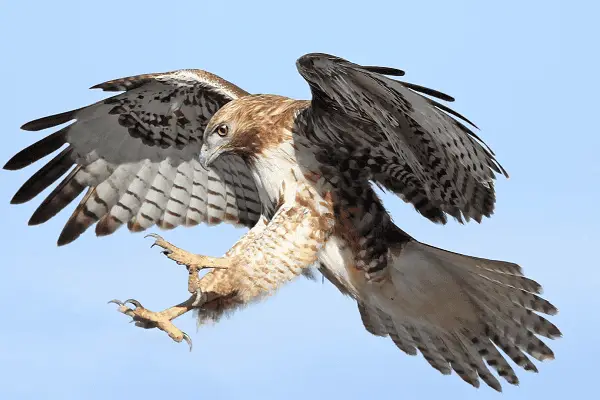
The Red-tailed Hawk is one of the most common hawks in Arizona. With its distinct red tail feathers, this majestic bird is easily recognizable and a favorite among birdwatchers. The Red-tailed Hawk is known for its impressive size, versatile hunting abilities, and breathtaking aerial displays.
The Red-tailed Hawk can often be seen soaring high in the sky, using its keen eyesight to spot prey from great distances. Its diet consists mainly of small mammals, such as mice, rabbits, and squirrels. However, it is also known to feed on reptiles, birds, and even carrion.
When it comes to nesting, the Red-tailed Hawk builds its large, sturdy nests in tall trees or on cliff ledges. The female lays two to three eggs, which are incubated for approximately 30 days. The parents take turns caring for the eggs and feeding the young until they are ready to leave the nest.
Arizona provides the perfect habitat for the Red-tailed Hawk, with its diverse landscapes ranging from deserts to mountainous regions. This bird of prey is adaptable and can be found in various ecosystems throughout the state, from urban areas to rural countryside.
Spotting a Red-tailed Hawk in Arizona is a thrilling experience. Keep an eye on open fields, forested areas, and along highways, where you may catch sight of this magnificent bird perched on a telephone pole or gliding effortlessly through the air. Don’t forget to pack your binoculars and camera for the best chance to observe and photograph these stunning creatures in their natural habitat.
Must Read Hawks in Florida
Other Hawks of Prey
Arizona is home to a diverse array of hawk species, each with its own unique characteristics and habitat preferences. Let’s explore some of the other magnificent hawks you can spot in the Grand Canyon State.
Sharp-shinned Hawk
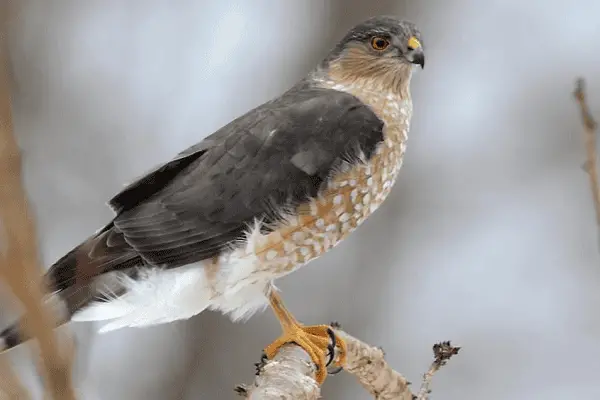
The Sharp-shinned Hawk is a small but agile predator known for its exceptional maneuverability and quick flight. With broad wings and a long tail, this hawk excels at hunting small birds and mammals in densely forested areas. Look for the Sharp-shinned Hawk in the high-elevation pine forests of Arizona.
Also Visit Types of Hawks in Iowa
Cooper’s Hawk
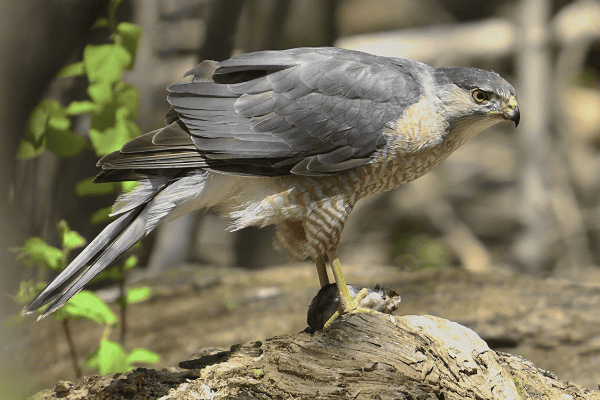
Similar in appearance to the Sharp-shinned Hawk, the Cooper’s Hawk is slightly larger and has a rounded tail. It is an ambush predator that often surprises its prey with swift, high-speed pursuits. Keep an eye out for this hawk in woodlands and suburban areas across Arizona.
Broad-winged Hawk
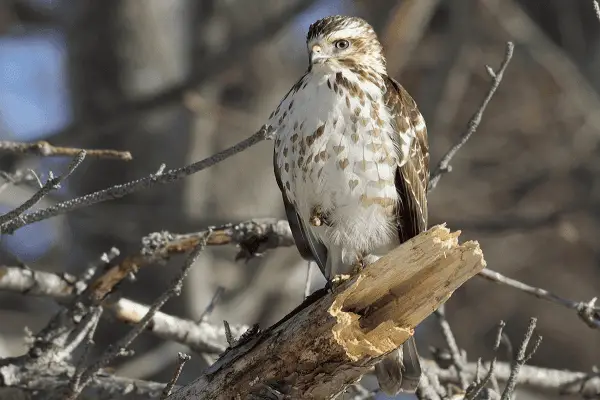
The Broad-winged Hawk is a migratory species that travels in large flocks called kettles during its annual migration. Identified by its broad wings and distinctive call, this hawk prefers wooded areas and coniferous forests. Look to the skies during the fall migration season to catch a glimpse of the Broad-winged Hawk in Arizona.
| Hawk Species | Characteristics | Habitat |
|---|---|---|
| Sharp-shinned Hawk | Small size, agile flight, sharp talons | High-elevation pine forests |
| Cooper’s Hawk | Medium size, rounded tail, swift flight | Woodlands and suburban areas |
| Broad-winged Hawk | Migratory, broad wings, distinct call | Wooded areas and coniferous forests |
Hawks in Mountainous Regions
In the mountainous regions of Arizona, you’ll find an array of hawks that have adapted to thrive in higher elevations. Two notable species that call these majestic landscapes home are the American Goshawk and the Rough-legged Hawk.
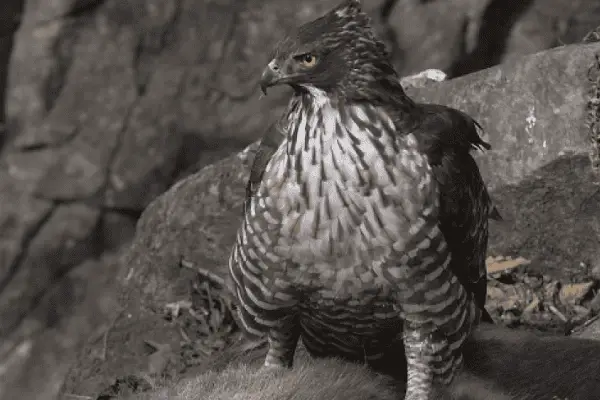
The American Goshawk (Accipiter gentilis) is a formidable bird of prey known for its size and strength. With a length of up to 27 inches and a wingspan of around 53 inches, this hawk is a sight to behold. It has a fierce hunting style, often pursuing its prey through densely forested areas. The American Goshawk is recognized by its slate-gray plumage and bold white eyebrows.
The Rough-legged Hawk (Buteo lagopus) is a remarkable winter visitor to Arizona’s mountains. These hawks breed in the Arctic tundra and migrate south to seek milder climates during the colder months. Named for their feathered legs, they are adapted to withstand harsh weather conditions. Look for them soaring above open fields and on fence posts, as they scan the ground for small mammals.
| Hawk Species | Scientific Name | Distinctive Features |
|---|---|---|
| American Goshawk | Accipiter gentilis | Slate-gray plumage, white eyebrows |
| Rough-legged Hawk | Buteo lagopus | Feathered legs, pale plumage |
If you’re seeking an opportunity to observe these magnificent birds up close, keep in mind some of the best spots for hawk-watching in Arizona’s mountainous regions. The Chiricahua Mountains, Santa Catalina Mountains, and the White Mountains are among the top locations known for their diverse bird populations. Prevalent thermal updrafts and expansive views make these areas ideal for spotting various hawk species, including the American Goshawk and the Rough-legged Hawk.
You may want to read Hawks Found in New York
Hawks in Wetland Areas
When exploring the breathtaking wetland areas of Arizona, keep an eye out for the majestic Common Black Hawk. This stunning raptor has a strong affinity for riparian habitats, making wetlands their preferred home. With their striking appearance and unique behaviors, the Common Black Hawk is a prized sighting for birdwatching enthusiasts.
The Common Black Hawk (Buteogallus anthracinus) is a medium-sized bird of prey known for its dark plumage and piercing red eyes, which add to its allure. They have a wingspan of approximately four feet and are characterized by their distinctive call, a shrill whistle that echoes through the wetlands.
These hawks are primarily found near riverbanks, marshes, and other water bodies, where they build their nests on tall trees, often near water sources. Their nests are large and made with sticks, lining them with softer materials such as moss, twigs, and ferns.
Habitat and Behavior
Common Black Hawks are year-round residents of Arizona’s wetland areas, where they display remarkable agility in flight, maneuvering through dense foliage and soaring above the waterways in search of prey. They are versatile hunters, adept at capturing a variety of prey, including fish, amphibians, reptiles, and small mammals.
“The Common Black Hawk demonstrates its impressive hunting skills by soaring high above the trees and rapidly descending to catch prey with its sharp talons.”
Unlike other hawks, the Common Black Hawk is known for its preference for a diet comprising mostly aquatic organisms. It will often perch near the water’s edge, patiently waiting for an opportunity to swoop down and snatch its next meal.
In addition to their hunting prowess, Common Black Hawks are also highly territorial. They fiercely defend their nesting sites and may engage in aerial displays to establish dominance and protect their young.
Also Read Hawks In Wisconsin
Conservation Status
While the Common Black Hawk is not considered globally threatened, it faces localized threats in certain areas, including the destruction of wetland habitats and the degradation of water quality due to human activities. Conserving wetland areas and implementing responsible land management practices are crucial in ensuring the long-term survival of these remarkable birds.
With their captivating presence and unwavering loyalty to wetland environments, the Common Black Hawk serves as a vivid reminder of the importance of preserving and protecting Arizona’s beautiful wetland ecosystems.
Hawks in Desert Environments
In the arid landscapes of Arizona, you’ll find an array of hawks specially adapted to thrive in these harsh desert environments. Among them are the Harris’s Hawk and the Gray Hawk, each with its distinct characteristics and behaviors.
Harris’s Hawk
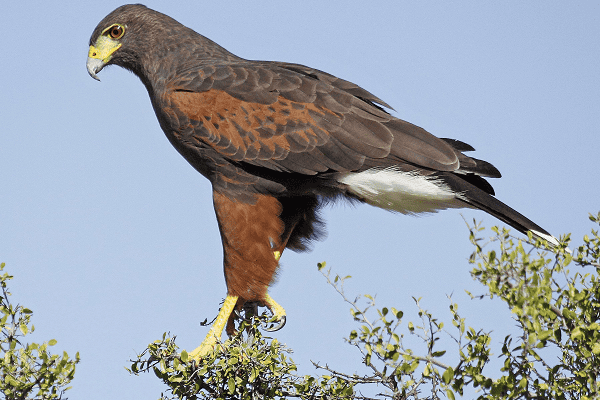
The Harris’s Hawk (Parabuteo unicinctus) is a remarkable bird known for its unique social behavior and hunting strategies. Unlike many other hawks that are solitary creatures, Harris’s Hawks are highly sociable and often hunt in family groups. This cooperative hunting behavior, known as “backstanding,” involves group members working together to flush prey out of hiding and corner it for capture. Harris’s Hawks have a wide-ranging diet that includes small mammals, birds, reptiles, and even insects.
One of the fascinating features of Harris’s Hawks is their striking plumage. They have a dark brown body, chestnut-colored shoulders, and bold white markings on their tail feathers. These markings are particularly visible when the bird is in flight, making them easily recognizable in the desert sky.
If you’re looking to spot a Harris’s Hawk in Arizona, keep an eye out for them in scrublands, desert areas, and desert grasslands. They are known to prefer habitats with taller vegetation where they can establish their nests on tall cacti, thorny shrubs, or trees.
Must Visit Hawks Found in United States
Gray Hawk
The Gray Hawk (Buteo nitidus) is another desert specialist found in Arizona. These medium-sized hawks are known for their stunning gray plumage, which helps them blend seamlessly with the arid surroundings. Their upperparts are predominantly gray, while their underparts display an intricate pattern of white and gray barring.
Unlike the Harris’s Hawk, Gray Hawks are solitary birds and maintain exclusive territories, which they defend vigorously against intruders. They primarily feed on small mammals, birds, reptiles, and large insects.
Look for Gray Hawks near riparian areas, including streams, rivers, and oases dotted throughout the desert regions of Arizona. These water sources provide the necessary habitat for their nesting and foraging needs.
| Hawk Species | Main Characteristics | Habitat |
|---|---|---|
| Harris’s Hawk | Distinct social behavior and cooperative hunting strategies | Scrublands, desert areas, and desert grasslands |
| Gray Hawk | Solitary nature and stunning gray plumage | Riparian areas near water sources in the desert |
While Harris’s Hawks and Gray Hawks are just two examples of hawks thriving in Arizona’s desert environments, they represent the incredible adaptations and resilience of these majestic birds. So, keep your eyes peeled and your binoculars at the ready for sightings of these remarkable hawks during your desert adventures in Arizona!
Hawks in Grasslands and Agricultural Areas
Grasslands and agricultural areas in Arizona provide vital habitats for a diverse range of hawks, including the majestic Swainson’s Hawk. These open landscapes offer abundant prey and nesting sites, attracting these magnificent birds of prey.
Migratory Patterns
Swainson’s Hawks are known for their impressive long-distance migrations. They undertake one of the longest migrations of any North American raptor, traveling from their breeding grounds in western North America to their wintering grounds in South America. These hawks can cover thousands of miles during their annual journey, making awe-inspiring spectacles as they traverse the skies.
Nesting Behavior
Swainson’s Hawks are skilled nest builders, constructing large stick nests high up in the trees or on man-made structures like utility poles. These nests provide a safe haven for raising their young. Breeding pairs establish strong bonds and return to the same nesting site year after year. During the breeding season, Swainson’s Hawks can be observed engaging in impressive aerial courtship displays.
Best Times to Observe
The best time to observe Swainson’s Hawks in grasslands and agricultural areas in Arizona is during the spring and fall migration periods. In spring, they can be spotted as they pass through the state on their way to their breeding grounds further north. In fall, as they head south to their wintering grounds, they provide fantastic opportunities for birdwatchers and hawk enthusiasts. The spectacle of hundreds or even thousands of Swainson’s Hawks soaring overhead is truly mesmerizing.
Raptors With Similar Appearance
Arizona is home to a diverse array of hawks, each with its own unique characteristics and appearance. Among them, the Zone-tailed Hawk and Ferruginous Hawk share a striking resemblance that can lead to misidentification.
One key feature that sets the Zone-tailed Hawk apart is its tail pattern. Unlike the Ferruginous Hawk, which displays a uniform coloration on its tail, the Zone-tailed Hawk showcases a distinct black and white banding that resembles the pattern of a Red-tailed Hawk. This distinct tail pattern is a crucial identifying feature to look for when differentiating between the two species.
Another distinguishing characteristic lies in their size and behavior. While both hawks are similar in size, the Zone-tailed Hawk tends to have a more compact and stocky appearance, whereas the Ferruginous Hawk appears larger and more robust. Additionally, their flight patterns can differ, with the Zone-tailed Hawk often soaring with a shallow, rowing motion, while the Ferruginous Hawk displays a more buoyant flight style.
It’s important to study these features and observe the hawks’ behavior and habitat to correctly identify the Zone-tailed Hawk and Ferruginous Hawk. By understanding the subtle differences between these raptors, birdwatchers in Arizona can enhance their hawk-watching experiences and gain a deeper appreciation for these magnificent creatures.
